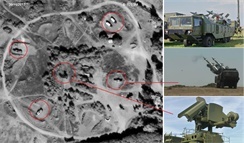http://www.israeldefense.com/?CategoryID=483&ArticleID=2598
 Satellite photography taken of the site near Latakia in Syria, which foreign publications claim was the site of an Israeli attack nearly 10 days ago, prove that the targets of the attack were advanced S-125 antiaircraft missile launchers. The launchers were in the process of undergoing upgrades, which made them a substantial threat as far as the Israeli Air Force was concerned.
Satellite photography taken of the site near Latakia in Syria, which foreign publications claim was the site of an Israeli attack nearly 10 days ago, prove that the targets of the attack were advanced S-125 antiaircraft missile launchers. The launchers were in the process of undergoing upgrades, which made them a substantial threat as far as the Israeli Air Force was concerned.
The satellite photos were taken on the actual day of the attack merely several hours before the missile batteries were destroyed, and were revealed by the investigative journalist Ronen Solomon.
The photography was carried out on the day of the attack by a company that offers satellite services to the US defense establishment, despite the fact that it usually focuses on photography in other Middle Eastern arenas, with emphasis on the efforts against Al Qaeda. It is possible that the reason the photography, which covered the site at precisely that timing, was carried out was due to a warning provided by Israel to the US moments before an attack. In any case, the satellite photography makes it possible to identify that an air defense base is situated at the center of the strike area, where Russian-produced S-125 battery was deployed.
According to Mr. Solomon, an analysis of the photos indicates that it is a battery that underwent upgrade to an M2 or K2-class S-125 system, which renders the battery mobile while additionally improving the locking systems and the ability to engage targets simultaneously. In its new version, the system is further equipped with optical systems for contending with electronic warfare disruptions, cruise missiles, a certain type of ballistic missiles and interceptions by US F-16 fighters.
The photos reinforce publications in the international media from 2012 which indicated that Russia upgraded the advanced antiaircraft systems while cooperating with the Syrian military in a joint project. The battery’s primary limitation with regards to the more advanced S-300 batteries is mostly in the ability to identify and engage long-range targets. The system is built for interception ranges of up to 40 kilometers. In the past, Russia utilized several contracts for the supply of S-300 systems. All of the contracts were carried out via upgrades to of aging S-75 or S-125 antiaircraft sites, so it is possible that the intent was to upgrade the S-125 batteries in the Latakia region to S-300 systems as well.
In addition, the satellite photography reveals that there is a courtyard of a structure that is generally abandoned (according to older photography of the areas) at a distance of several hundred meters from the location of the batteries that were apparently destroyed. The courtyard was turned into a parking lot for several vehicles that tow heavy loads such as missiles. The lot is located near weaponry warehouses of the kind that Israel bombed before in northern Damascus last May, according to international media. According to the photography and the reports from Syria, it is possible to assess now that the target of the attack in the area of Latakia was in fact the air defense base that housed antiaircraft systems undergoing upgrades, which posed a threat to the IAF’s freedom of operation.
Israel has refused to officially respond to claims that it attacked targets in the Latakia region. However, USS officials confirmed that Israel was indeed behind the attack, in publications that appeared in US media. Without discussing the publications on the attack themselves, Israeli officials confirmed that advanced antiaircraft batteries, such as those that were at the site attacked in Latakia, are a considerable threat to the IAF’s freedom of operation, and Israeli officials claimed that there is concern that Syria might transfer the advanced batteries to the hands of the terror organization Hezbollah in Lebanon.









